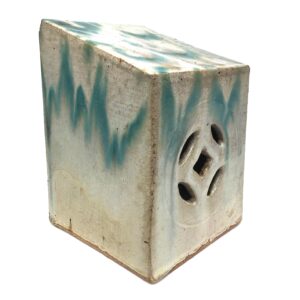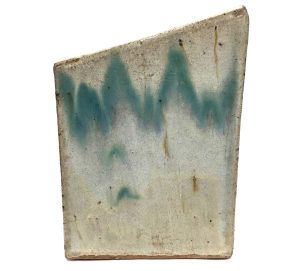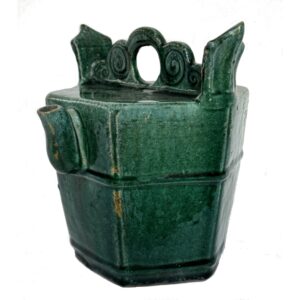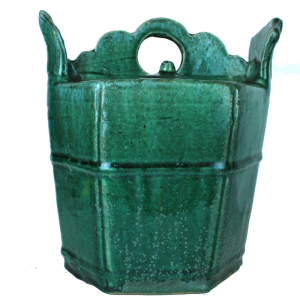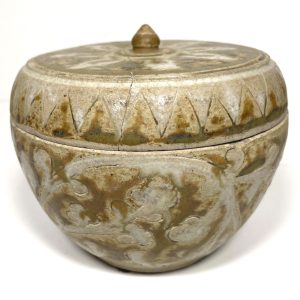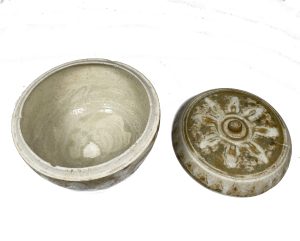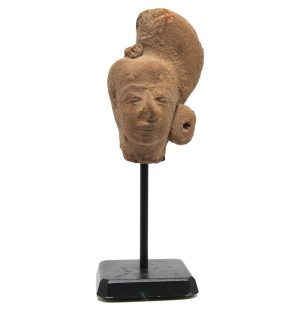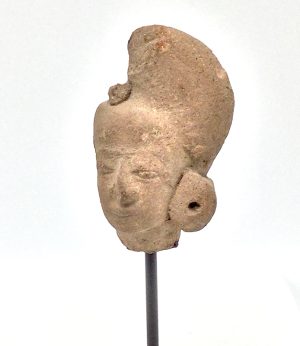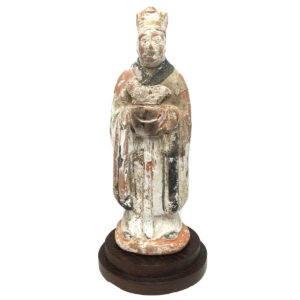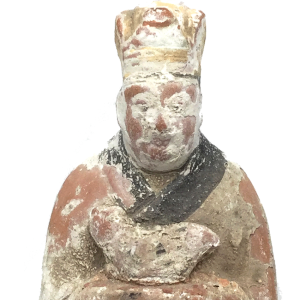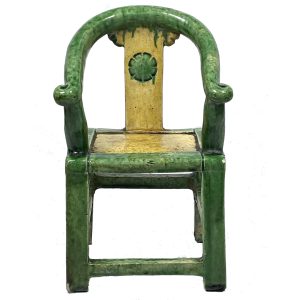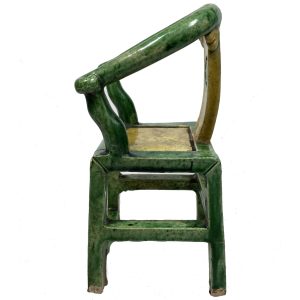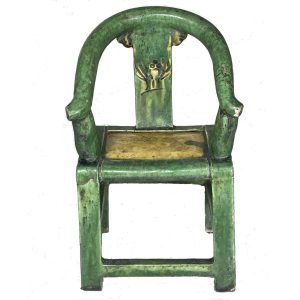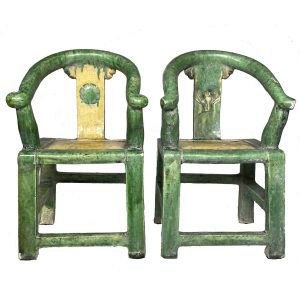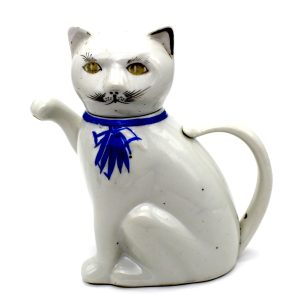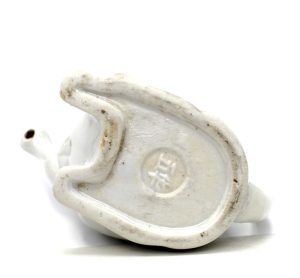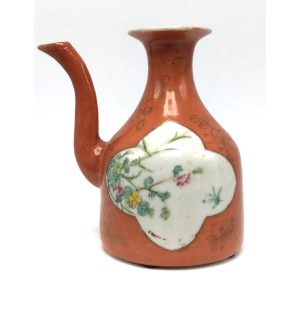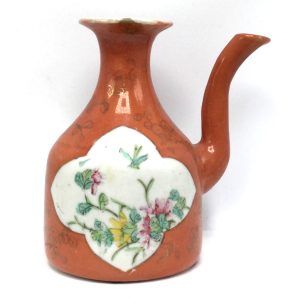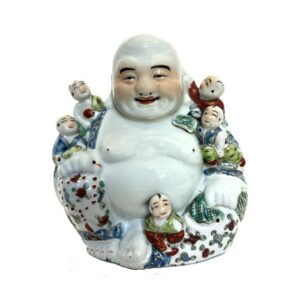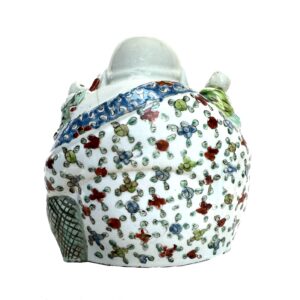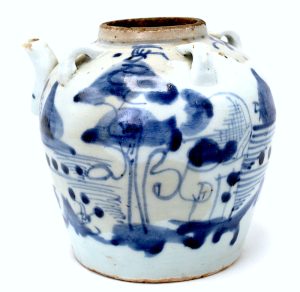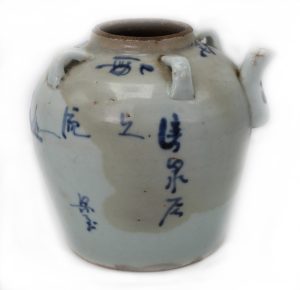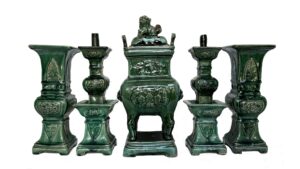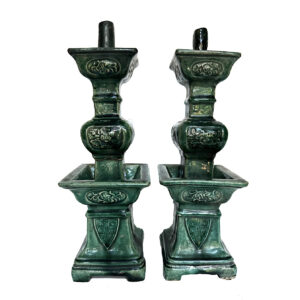Showing 13–24 of 45 results
-
Sale!


$235.00 Original price was: $235.00.$185.00Current price is: $185.00.
H: 7.25″ W: 5″ D: 5″ | FREE SHIPPING WITHIN CONTINENTAL U.S.!
This five-sided Shiwan stoneware pillow with slanted top, open bottom, vibrant glazed surface, and etched coin and diamond design was used for smoking opium as the cool shell cradled the users’ heads and necks and offset the warmth of smoking and the hollow inside stored valuables. We have another which can be paired with it. If a candle is placed inside it emits an amazing shadowy form of a coin, which appealed to those in an opium state.
-
Sale!


$395.00 Original price was: $395.00.$285.00Current price is: $285.00.
H: 9″ W: 8.375″ D: 5.5″ | CALL 213-568-3030 OR EMAIL [email protected] FOR SHIPPING COST
This very attractive antique green glazed teapot is typical of the stoneware pottery made in the Shiwan kilns in Guangdong during the 18-19th century. Finely designed, this hexagonal pot has a yoked rounded handle with spiral decorations that adds a delightful touch. The pieces are well known for their brilliant flambé—or flame-like quality – glazes such as apple green glaze of this pot.
-


$215.00
Ht: 4.25” Dia: 5” | FREE SHIPPING within continental U.S.!
Produced in Thai kilns in the 14th to 15th centuries, Sawankhalok glazed stoneware lidded bowls were distributed through Southeast Asia along with a variety of larger and smaller items. Lidded bowls like this were used to store many things, especially spices, powders and cosmetics, betel nut chewing materials, and medicine. This bowl rests on a thick foot, has a lid with a radiating glazed petals surrounding an olive-brown glazed lotus bud handle. The cover’s side has a band of pointed star points and the body is covered with an intricate scroll of white glazed colored branches and florals.
-


$195.00
Ht: 4” W: 1.5” D: 1.75”|FREE SHIPPING WITHIN CONTINENTAL U.S.!
This terracotta head was crafted during the Majapahit Empire in Java and was either part of a Hindu bas-relief frieze or made as a freestanding figurine. Most figures found are small decapitated heads with no bodies, and it is very rare to find a complete figure with a naturalistic facial expression. As with many heads, this one displays Javanese facial features, hairstyles and ear ornamentation typical of the period. It has a naturalistic facial expression and wears large round coiled earrings, possibly suggesting it represented someone of the upper classes. It is in very good condition given its age and use and is mounted on a metal stand. This items pairs with Majapahit Terracotta Head 1137.
-


$395.00
In China a set of earthenware Zodiac attendant figures was made as a 12 piece grouping, with each figure holding a small calendar animal with each year represented by a different animal – rat, ox, tiger, rabbit, dragon, snake, horse, goat, monkey, rooster, dog, and pig or boar – in a repeating 12-year cycle. Although…
-
Sale!


$685.00 Original price was: $685.00.$395.00Current price is: $395.00.
H: 7.375″ W: 4.375″ D: 3.75″ | FREE SHIPPING WITHIN CONTINENTAL U.S.!
Horseshoe chairs were considered a sign of rank used by officials and often ancestral figures were portrayed sitting in them to reflect their high status. This well-modeled green glaze ceramic mingqi of a horseshoe chair is decorated with a yellow glaze imitating caning and the decorative carved circular design on the splat. It pairs perfectly with Ming Dynasty Earthenware Horseshoe Chair 3330 and together would add to a fine collection of miniature Chinese ceramics.
-
Sale!


$685.00 Original price was: $685.00.$395.00Current price is: $395.00.
H: 7.375″ W: 4.375″ D: 3.75″ | FREE SHIPPING WITHIN CONTINENTAL U.S.!
Horseshoe chairs were considered a sign of rank used by officials and often ancestral figures were portrayed sitting in them to reflect their high status. This well-modeled green glaze ceramic mingqi of a horseshoe chair is decorated with a yellow glaze imitating caning and the decorative carved circular design on the splat. It pairs well with item Ming Earthenware Horseshoe Chair 3331. This would be a fine addition to a collection of antique ceramics or simply a beautiful decorative piece to brighten a small space.
-


$145.00
Ht: 6.25” W: 5.5” D: 3.25” | FREE SHIPPING WITHIN CONTINENTAL U.S.!
This charming antique white glazed porcelain figurine is a cat teapot with a raised paw with removable head for pouring liquid into the vessel and long sinuous tail as a handle to pour liquid from the opening at the end of the paw. The hand painted design is whimsical and colorful with a thin ribbon-like blue collar and a dangling ornamental bow with black accents defining the face, ears, head and paws.
-


$235.00
H: 4.875″ W: 4.5″ D: 3.25″ | FREE SHIPPING WITHIN CONINENTAL U.S.
This elegantly shaped and beautiful high-fired antique porcelain ewer was decorated on its outside with a saffron-colored glaze called a coral red glaze. The sides have a white glazed quatrefoil panel with hand-painted multi-colored floral designs on a white background within a gold frame interspersed among sinuous gold leaf vines across the body and neck and a white glaze covers the inside and bottom. Its beauty is enhanced with its graceful spout, colorful white and gold panel beautiful.
-
Sale!


$850.00 Original price was: $850.00.$700.00Current price is: $700.00.
H: 10.25” W: 9.5” D: 4.5” | FREE SHIPPING WITHIN CONTINENTAL U.S.
Known as the Laughing, Happy, or Fat Buddha, Budai is regarded as a deity of contentment and plenty. Like most Early Chinese Republic porcelains this piece is hand decorated in famille rose enamels with vivid blue, red, and green pigments portrayed as a stout, smiling, bald monk in robes with a large, exposed pot belly surrounded by five children. Since the stomach is considered the seat of the soul in Chinese beliefs, it demonstrates his open heartedness. His wide smile attracts the children surrounding his body indicating his regard for them and his joy when they encircle him and well as the belief he can bequeath families with children.
-


$135.00
H: 5” W: 5.25” D: 4.5” | FREE SHIPPING!
Utilitarian ceramics like this were used in home kitchens and restaurants to hold oil, sauces, soy or other liquids. This spouted blue and white porcelain jar has four loops, also called lugs, so a natural fiber such as rattan could be threaded to either secure a top create a way to hang it to a peg. Sealing the top was very useful if the jars contained liquid and needed to be transported. The piece is decorated in a free and expressive manner with a charming impression of a country scene of a building in a landscape surrounded by tall trees. The cobalt is thick and dark in some areas of the foliage and applied with a thin, sparing and light brush elsewhere.
-
Sale!


$2,950.00 Original price was: $2,950.00.$1,975.00Current price is: $1,975.00.
Overall Ht: 16” W: 28” D: 6” | CALL 213-568-3030 OR EMAIL [email protected] FOR SHIPPING COST
This rare 5 piece apple green Shiwan ceramic “garniture set” comprised of two vases, 2 candlestick holders and a large censer was originally placed on a family altar in a central room which was the focal point of an affluent Chinese dwelling. Ritually used to perform ancestral offerings on a daily, semimonthly, and seasonal basis, compete sets in excellent condition are relative rare.
End of content
End of content

